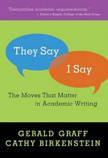
They say/I say : the moves that matter in academic writing is a lovely introduction to academic argument by Gerald Graff and Cathy Birkenstein that shows how academic argument is a dialogue in which an individual acknowledges what others are saying and at the same time makes a space for what s/he is saying. The chapter headings summarize the book fairly well:
Part 1. "They say"
ONE: "They say" (Starting with What Others Are Saying)
TWO: "Her Point Is" (The Art of Summarizing)
THREE: "As He Himself Puts It" (The Art of Quoting)
Part 2. "I Say"
FOUR: "Yes / No / Okay, But" (Three Ways to Respond)
FIVE: "And Yet" (Distinguishing What You Say from What They Say)
SIX: "Skeptics May Object" (Planting a Naysayer in Your Text)
SEVEN: "So What? Who Cares?" (Saying Why It Matters)
Part 3: Tying It All Together
EIGHT: "As a Result" (Connecting the Parts)
NINE: "Ain't So / Is Not" (Academic Writing Doesn't Mean Setting Aside Your Own Voice)
TEN: "In Other Words" (The Art of Metacommentary)
Besides showing "the moves that matter" in an easily understandable way, the book provides templates to help students make these moves in their own writing. Graff and Birkenstein anticipate "naysayers" on templates as being prescriptive and "stifling creativity," but respond by noting their classical history and present modern examples from academic journals. Then adding their own voice, they write,
One virtue of such templates, we found, is that they focus writers' attention not just on what is being said, but on the forms that structure what is being said. In other words, they help students focus on the rhetorical patterns that are key to academic success but often pass under the classroom radar.
Elsewhere:
In showing students how to make such moves, templates do more than organize students' ideas; they help bring those ideas into existence.
For ESL/EFL students, making explicit the implicit is crucial in learning to write an academic argument. And this book does that in a way that captures the essence of academic writing and represents it in a down-to-earth way. Although written for L1 composition, They Say / I Say is a book I plan to read and re-read this summer and incorporate into my classes next fall.